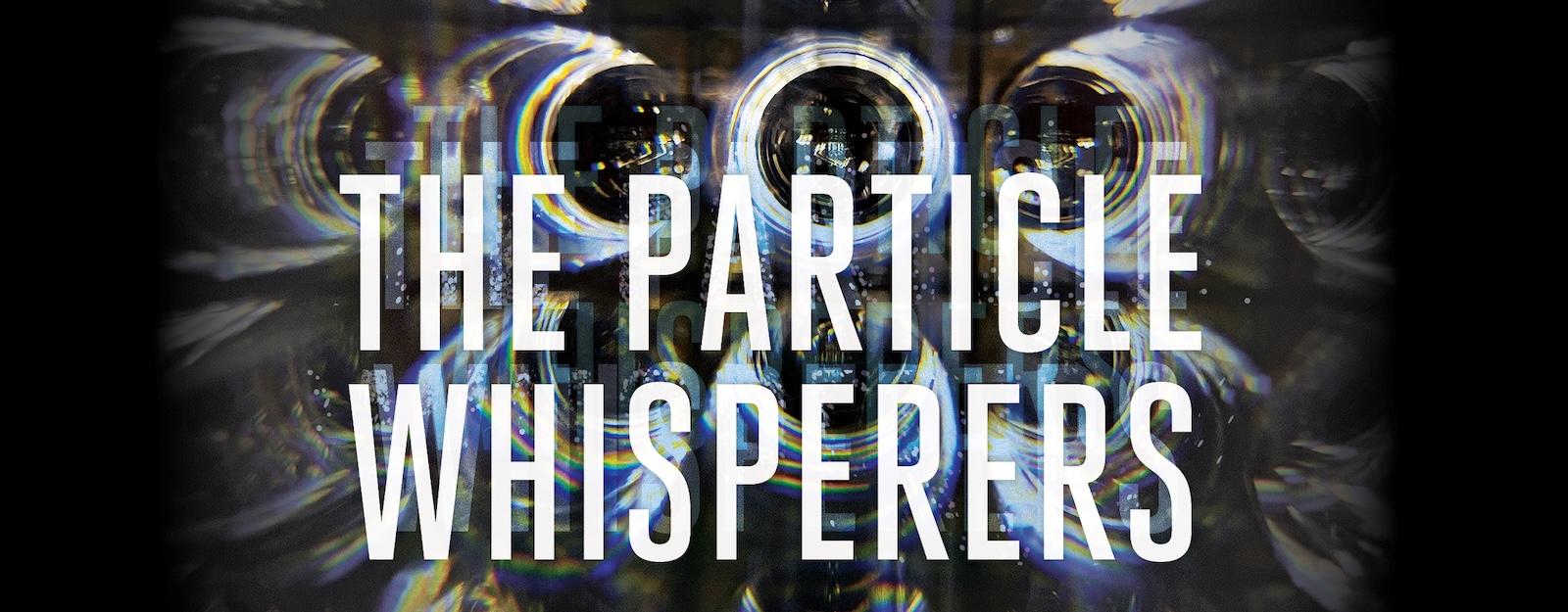The Particle Whisperers
GW experimental physicists are pioneering big science at the smallest scale. With cutting-edge tech and state-of-the-art systems, faculty and students are on the frontlines of a subatomic revolution.
Story // John DiConsiglio
It’s well past midnight in Hall D of the Thomas Jefferson National Accelerator Facility—or JLab—in Newport News, Virginia, and the counting house is humming with energy.
Some of it’s coming from the banks of computers and high-definition monitors inside the JLab control room flickering with rows of readouts. Some of it’s coming from the George Washington University physics students, bleary-eyed on a graveyard shift, tracking a dozen displays as they record terabytes—petabytes!—of data.
And a lot of it is coming from the football fields-sized machinery pulsating three flights below.
Deep in the JLab basement, a network of systems is running around the clock—a mile-long accelerator propelling electrons around a NASCAR-like track; a beam of supercharged rays firing down concrete tunnels toward high-speed collisions with elemental targets; and a maze of massive detectors capturing scattered particles and relaying results to the counting-house students like messages from the quantum world.
“There’s so much happening all at once!” said sixth-year Ph.D. candidate Phoebe Sharp, M.S. ’22, M.Phil. ’23, who has collected—“counted”—experiment data on shifts in the JLab counting house since 2021. “You’re watching all these screens. They’re flashing and streaming. Alarms go off. It’s overwhelming!”
On quiet shifts, when the calming blue rectangles on her monitors signal all systems are go, Sharp has a moment to savor the science around her. “The itty-bitty particles that are inside of me are the same ones we’re studying in these giant machines,” she said. “I get a little heady just thinking about it.”
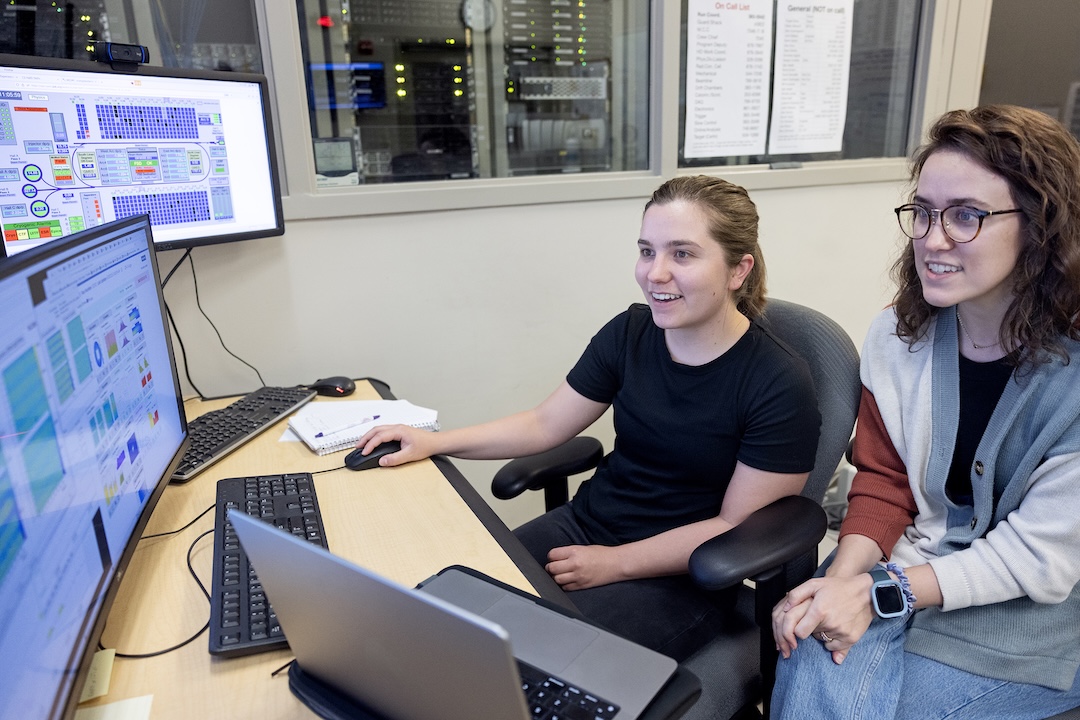
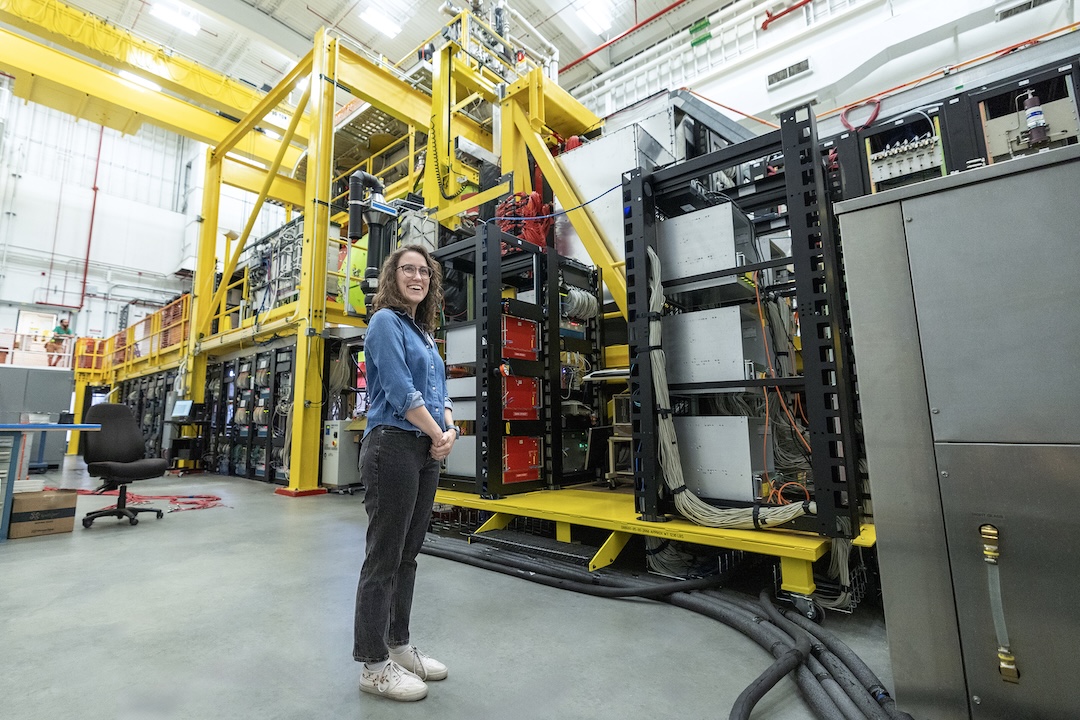
At left, undergraduate student Quinn Stefan and PhD candidate Phoebe Sharp keep a close watch on the monitors in the counting house. At right, Sharp in front of the large solenoid magnet in Hall D of JLab. (Credit: Jefferson Lab)
In research hubs around the world, GW experimental nuclear physicists are piecing together the building blocks of the universe one subatomic Lego piece at a time. From a bustling Virginia shipping town to the wide-open fields of the Swiss countryside, GW scientists are harnessing energy with high-tech instruments to look deep inside the smallest particles in existence—billions of billionths of a centimeter. What they’re finding may answer some of science’s biggest questions, from the origins of the Big Bang to the development of quantum technologies.
“We’re getting new data on things that we can’t even see,” said Assistant Professor of Physics Axel Schmidt, who leads several JLab experiments. “It’s a very exciting time. There’s something really magical happening.”
At the Paul Scherrer Institute (PSI) in Villigen, Switzerland, Professor of Physics Evangeline J. Downie is part of an international team using accelerators and lasers to measure the size of the proton, an unsolved puzzle in physics that could reveal new forces and particles.
At Triangle Universities Nuclear Laboratory in North Carolina, Professor of Physics Gerald Feldman is mapping the internal structure of neutrons by firing photons at frozen chemicals—colder than -400 Fahrenheit—and capturing the scattered rays with barrel-sized crystals.
And at JLab, a U.S. Department of Energy (DOE) Office of Science national laboratory that has partnered with GW for over three decades, Schmidt is cutting even deeper into the atom—wielding a gamma-ray scalpel to detect the tiniest bits of matter and the ties that bind them together.
“There’s something cool about having a tangible relationship to experiments on these tiny particles,” Sharp said. “Physics can sometimes seem like such an abstraction. This work makes it feel real.”
Inside the Atom
Everything around us—from stars to sneakers to grains of sand—is made of atoms, structures so small that millions would barely match the width of a hair. But atoms themselves aren’t solid. They’re mostly empty space with a dense center—the nucleus—and negatively charged electrons orbiting around it.
The nucleus itself contains even smaller particles: neutral neutrons and positively charged protons which determine the atom’s chemical nature—one proton for hydrogen, for example, or six for carbon. And these particles are made of smaller-still components: quarks, which are held together by a field of gluons—the “glue” that cements them together.
Across the Physics Department at the Columbian College of Arts and Sciences, GW nuclear physicists are spearheading research projects aimed at the heart of the atom—searching for new particles, probing powerful binding forces and decoding the mysteries of matter in the universe. Their work goes beyond unlocking cosmic questions like what celestial objects are made of. It also deeply connects to real-world challenges in fields from medicine to industry. The same forces that explain how particles interact, for example, have powered innovations in technologies like MRI machines, nuclear power and even smartphones.
“At its core, they are studying fundamental particles that will lead to a deeper understanding of everything around us,” said Physics Department Chair and Associate Professor Alexander J. van der Horst. “Physicists always have a drive for knowledge. But they also ask: How can we use that knowledge to make things better for humanity?”
Seeking Synergy
Nuclear physics has long been a GW pillar—from Big Bang theorist George Gamow’s foundational work on quantum theory conducted on campus to Nobel Prize-winner Niels Bohr announcing the splitting of the uranium atom at a 1939 Foggy Bottom conference. In his Corcoran Hall office, Schmidt even works at the same desk where GW Professor of Physics Edward Teller, the so-called “Father of the Hydrogen Bomb,” sat in the 1930s and ’40s.
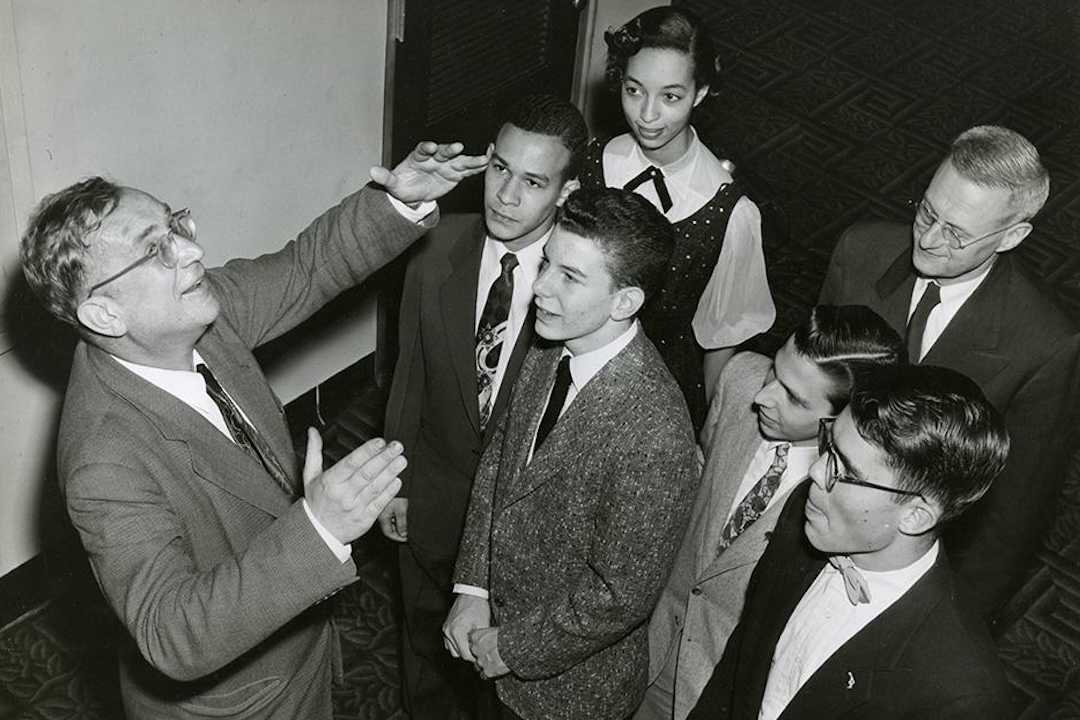
Physicist George Gamow (left, with GW students) first devised the Big Bang theory at Corcoran Hall.
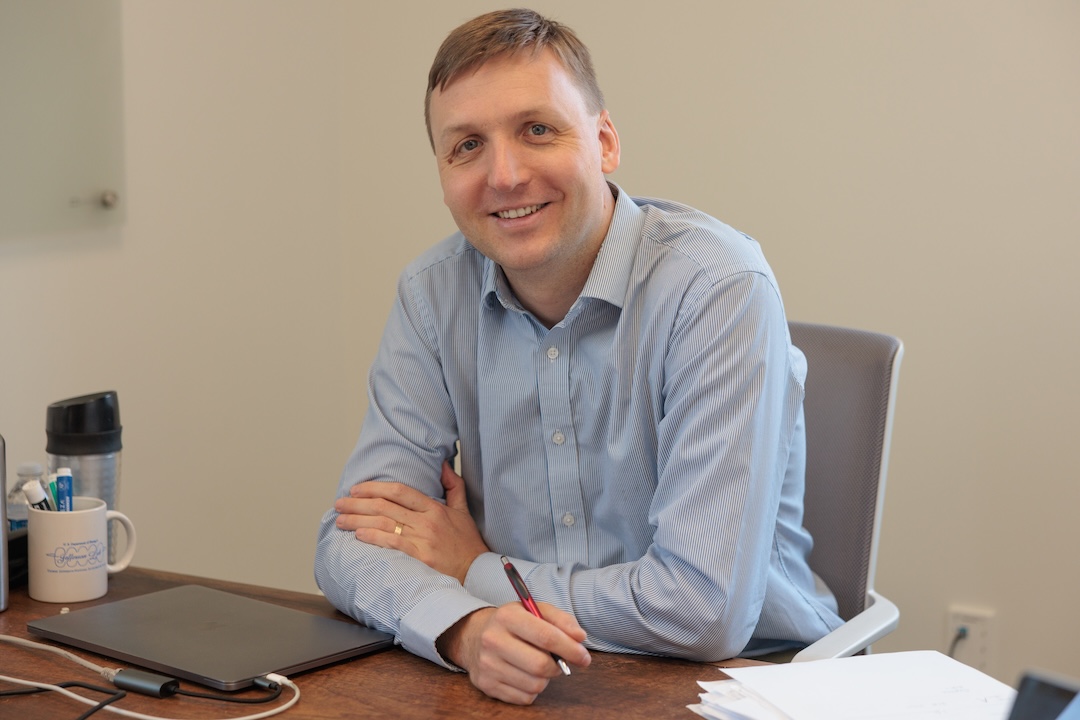
Axel Schmidt, seen here at the Edward Teller desk, co-leads the GW Jefferson Lab Group.
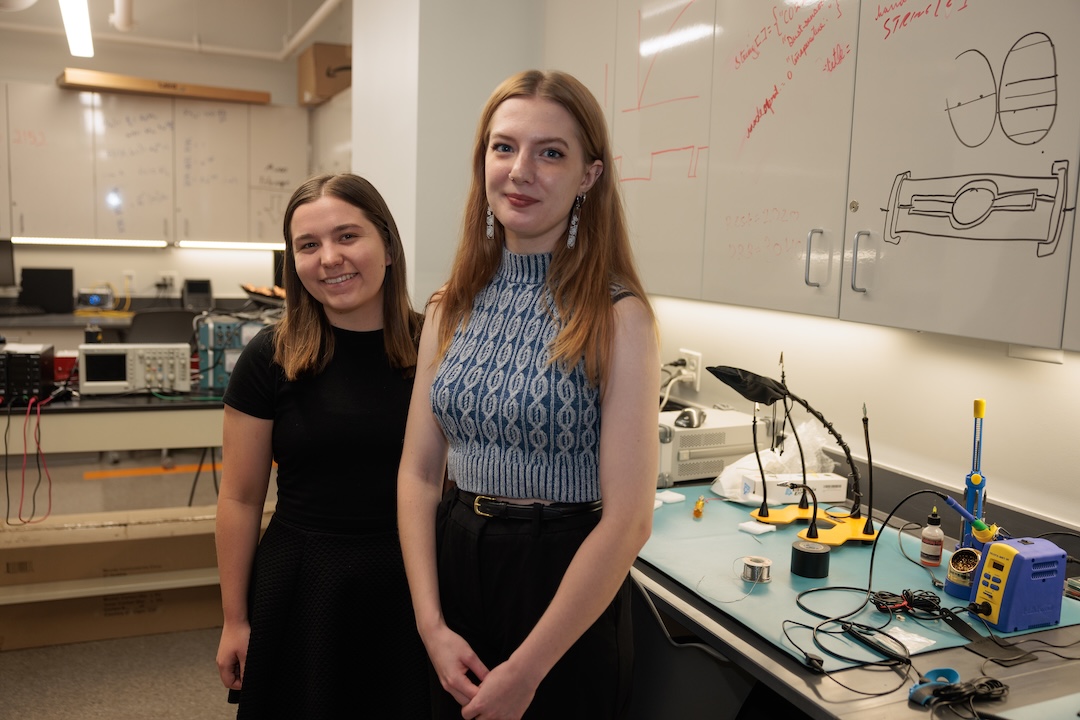
Physics students Quinn Stefan (left) and Olivia Nippe-Jeakins, president of the GW Chapter of Physicists of Underrepresented Genders.
The lineage of department nuclear experimentalists stretches from Gamow and Teller to Professor Emeritus William J. Briscoe, who first pioneered the GW-JLab partnership. Today, Schmidt leads the GW Jefferson Lab Group with Research Professor Igor Strakovsky and a team of postdocs, graduate and undergraduate researchers.
Behind the scenes, GW physics theorists like Harold Grieshammer, Michael Doering and Andrei Afanasev run the numbers that make the lab-and-laser experiments possible. “It’s all intertwined—there’s a synergy,” van der Horst said. “In our nuclear group, the theorists and the experimentalists don’t live in separate worlds. They are always talking to each other.”
Likewise, students benefit from the collaborative overlap. As an astronomy and astrophysics major, rising senior Olivia Nippe-Jeakins is drawn more to black holes than quarks—and never expected one of her research opportunities to be in Schmidt’s nuclear physics team. But among his JLab experiments, Schmidt examines a phenomenon called short-range correlations, where protons and neutrons are so close together that they influence each other’s momentum. That same reaction also takes place in the core of neutron stars—fittingly for Nippe-Jeakins’ research focus.
“We can’t bring a neutron star to Earth. This is as close as we’re going to get,” Nippe-Jeakins said. “The tiniest things in the universe and the biggest turn out to have similar characteristics. I love that I can look at it from both extremes.”
The Big Toys
From the outside, JLab looks more like an anonymous office park than an epicenter of particle research. There’s little indication that beneath the L-shaped complex off I-64 lies a subterranean hangar with accelerators, detectors and lasers —the “big toys,” as Schmidt calls them.
Once inside the experimental hall, researchers flash their badges at the security gate and fasten their radiation-measuring dosimeters. Twenty-five feet below them, an underground tunnel winds its way toward a racetrack-shaped course.
That’s the Continuous Electron Beam Accelerator Facility, one of the world’s most sophisticated particle accelerators. Like scientific stock cars, clusters of electrons accelerate around the track for nearly a mile, gaining energy with each lap. As magnets direct them around the arcs, the particles hit close to light speed and reach energies of up to 12 billion electron volts.
After five laps, the turbocharged electrons become a thin, focused beam like a microscopic laser pointer. Encased in a pipe, the beam fires down the JLab halls toward a target, which, depending on the experiment, could be elements like liquid hydrogen, deuterium or carbon. When the beam hits its target, the crash sends particles flying in different directions. A surrounding network of detectors capture data from the scattered particles and relay it to the counting house above. Across the rows of monitors, scientists and students reconstruct the subatomic collisions like police reviewing security footage of a car accident.
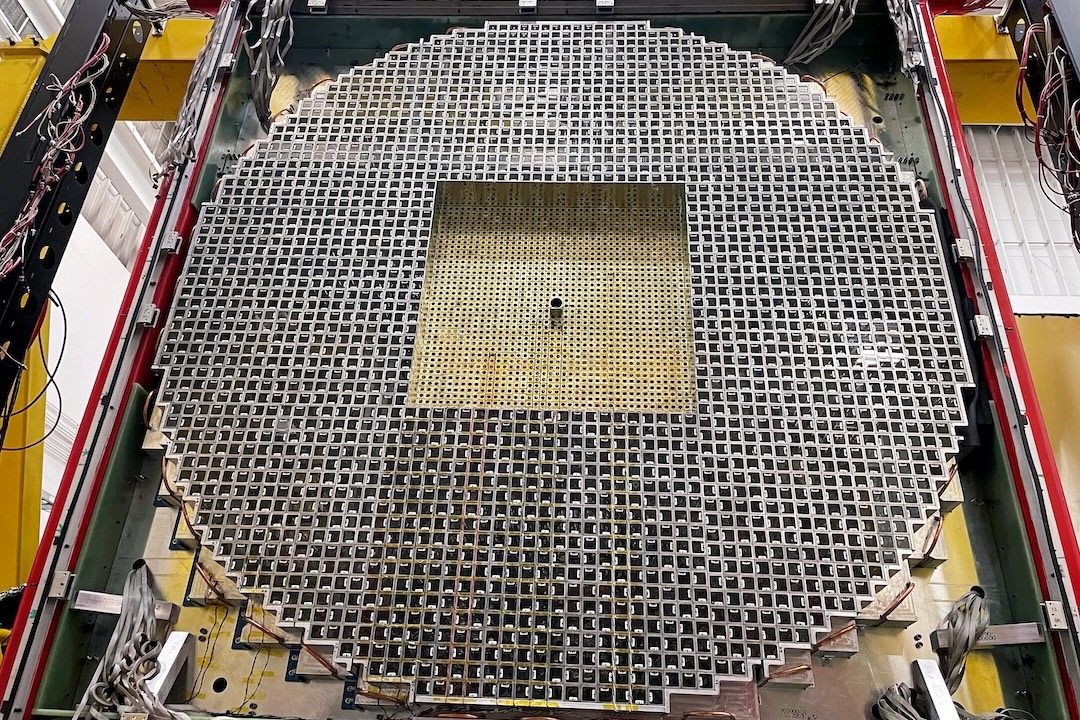
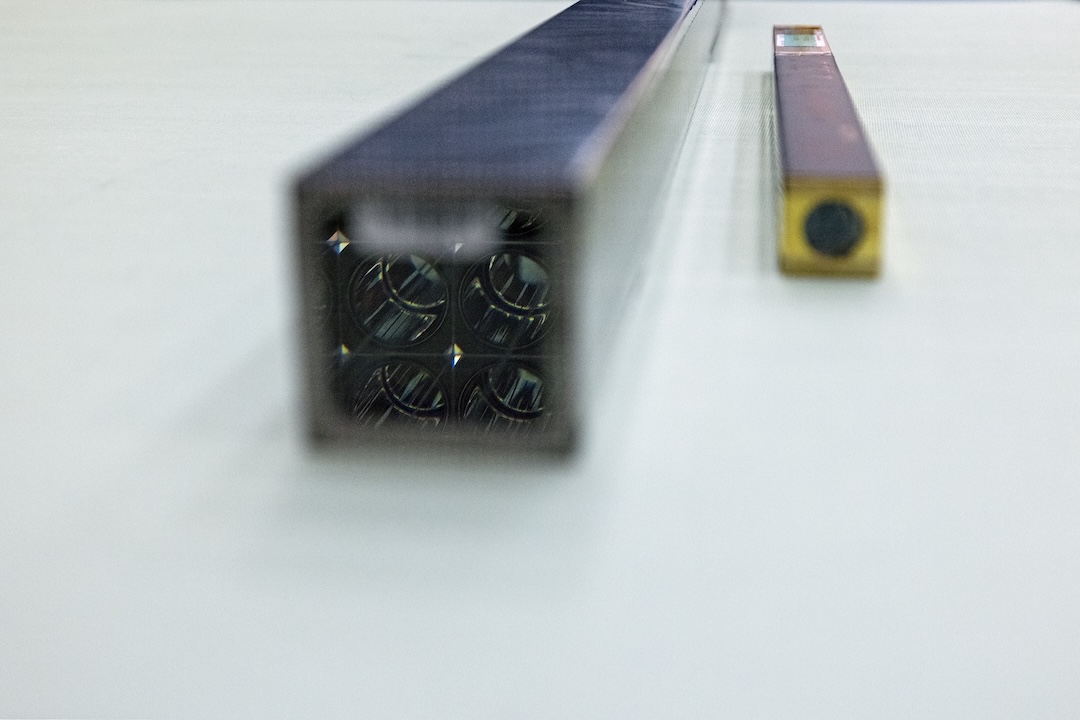
The forward calorimeter is the main detector used for the GlueX experiment. The detector consists of larger bricks made of lead glass and smaller bricks made of lead tungstate crystal that convert particle energy into a flashes of light. (Credit: Jefferson Lab)
In his JLab work, Schmidt manipulates his beam more like a precision “sharpshooter,” he said, than a reckless driver. His work often involves firing an electron beam through a thin wafer of diamond which pulls out energy into a beam of gamma rays—or photons. Photons don’t carry an electric charge and, unlike electrons, their energy can be fully absorbed by the proton or neutron they hit.
In one of his primary experiments, dubbed GlueX, Schmidt studies the forces that hold—“glue”—matter together. The GlueX team searches for traces of ephemeral unstable particles, many of which contain excited configurations of quarks and gluons. The photon beam hits a liquid hydrogen target and sets off a spray of particles whose scattering angle could potentially map the first-ever comprehensive diagram of strong force interactions.
“Our overarching goal is to learn the rules of the universe that would help us manipulate energy at densities vastly exceeding chemical or even nuclear power,” Schmidt said. “The new capabilities of our accelerators, experiments and detectors are giving us multidimensional information that is so advanced it’s like going from an X-ray to a CAT scan.”
Collision Course
To understand what matter is made of and the forces that shape our physical universe, physicists use accelerators to smash subatomic particles into each other at very high speeds, recreating the conditions of the early universe. At the Jefferson Lab's Continuous Electron Beam Accelerator Facility (illustrated here), GW faculty and students are smashing photons into different elements to investigate the forces that "glue" matter together as part of an experiment called GlueX.

Electrons are injected into a mile-long accelerator.

Guided by powerful magnets, the electrons loop around the accelerator until they reach close to the speed of light.

An electron beam fires through a thin diamond wafer, which pulls out energy into a beam of gamma rays–or photons.

The photon beam collides with a liquid helium* target inside of a large magnet, scattering different particles picked up by detectors.
* The photon beam can collide with a variety of targets, from liquid helium or hydrogen to solid graphite wafers.

Data from the detectors is transmitted to scientists in the counting house, who will reconstruct what happened at the moment of impact.
The Proton Puzzle
Across the Atlantic at PSI, Downie’s lower-voltage accelerators and beams aren’t buried in an underground bunker. They’re housed in a Swiss village 40 minutes outside of Zurich. Inside a barn-like structure across the Aare River, she and her students and colleagues—including Emeritus Professor Briscoe and Professor of Physics Andrei Afanasev—are part of an international partnership solving a mystery at the center of the proton.
A cornerstone of centuries of science, the positively charged proton is too small to be measured directly. Instead, physicists typically use the electron scattering technique: firing a beam of negatively charged electrons at a hydrogen atom and measuring the scattering angle as the individual electrons deflect off the nuclei’s lone proton. Another method involves measuring the energy levels of the electron in a hydrogen atom in a process known as spectroscopy.
In 2010, scientists at PSI, attempting to fine-tune their measurements, replaced the electron in the hydrogen atom with a muon—a nearly identical particle that’s 200 times more massive—and performed a spectroscopy measurement. Their results shook up the physics world. The proton, they determined, was smaller than long believed—by a trillionth the width of a poppy seed.
That infinitesimally tiny degree sent scientists “running in circles,” Downie said, to figure out why the proton seemed to shrink.
“The proton makes up about 50 percent of all observable matter and we aren’t sure how large it is,” Downie said.
In 2012, Downie and her colleagues joined the MUon proton Scattering Experiment (MUSE) Collaboration to reconcile the measurement. The project harnesses PSI’s proton accelerator to produce what Downie calls a “messy” particle-mixed beam. More like the car-crash approach than the laser pinpointing method, the beam bounces particles off the single proton inside a hydrogen atom—while detectors measure the scattering angles to estimate the proton’s true size.
“It feels like I’m on the forefront of this very fundamental research from the experimental side,” said Rachel Ratvasky, M.S. ’24, a fourth-year Ph.D. candidate who has worked as a research assistant on MUSE for the last three years. “I’ve been exposed to new areas of physics that I didn’t even know existed.”
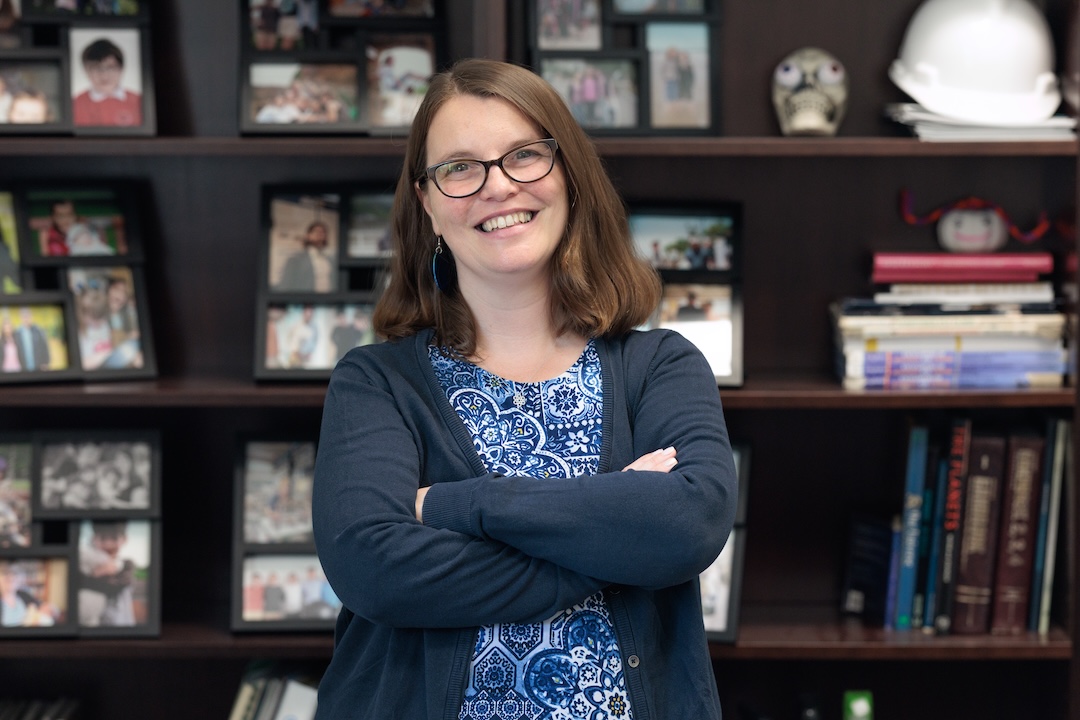
Professor of Physics Evangeline Downie is part of an international team using accelerators and lasers to measure the size of the proton.
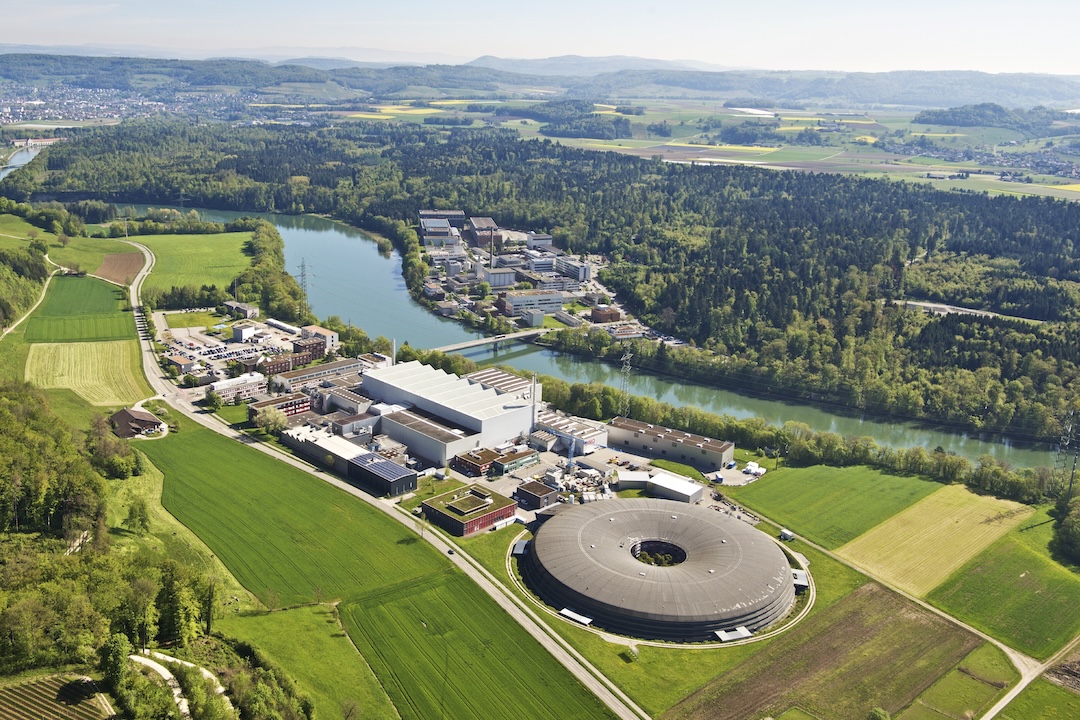
The Paul Scherrer Institute in Villigen, Switzerland, where Downie is part of the MUon proton Scattering Experiment (MUSE) Collaboration.
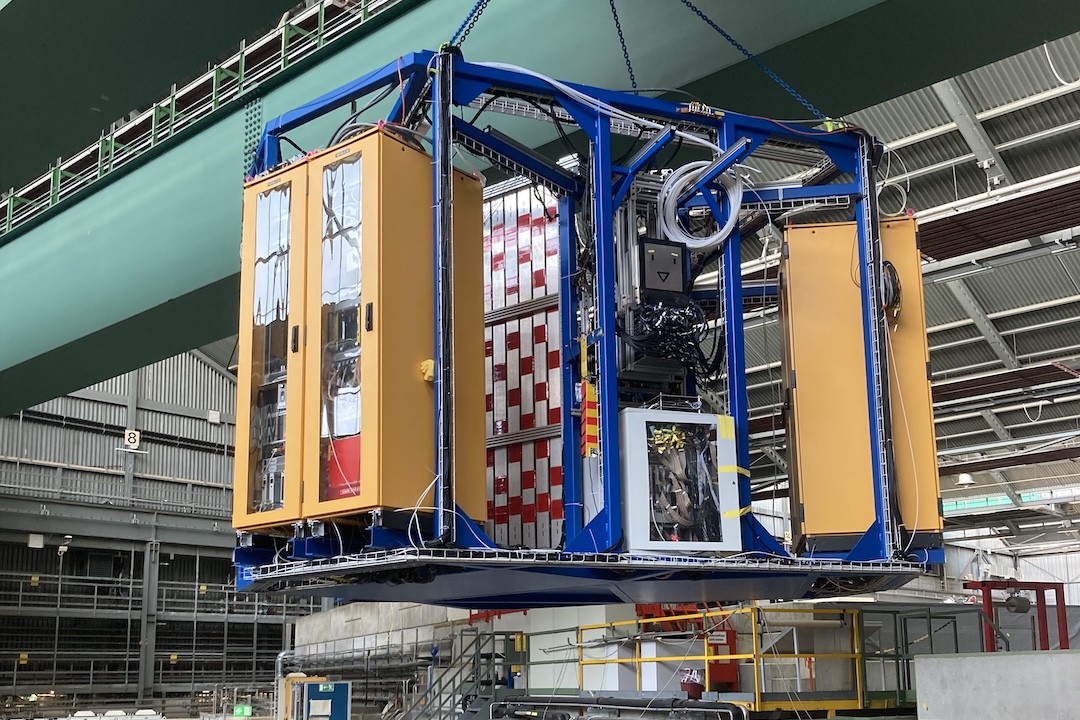
The MUSE instrument at PSI in Switzerland. (Credit: Evangeline Downie)
Driven largely by federal funding sources—the MUSE project is backed by funding from the National Science Foundation while Schmidt’s group is supported by a DOE grant—research at facilities like PSI and JLab also drives breakthroughs outside the lab.
Some are based directly on the knowledge obtained from the atom. Quantum computing codes, for example, are patterned on insights into the spin of nucleus particles. Others are inspired by the experiments themselves. Some childhood cancer treatments use the same proton accelerator techniques in MUSE to precisely target tumors with radiation. And the powerful magnets developed for JLab accelerators and detectors are the model for better, cheaper and more reliable magnets in semiconductors, MRIs and other technologies.
“Nuclear physics has been the launching point to develop better magnet technology,” Schmidt said. “It is not such a big stretch to go from a hospital MRI magnet to the big solenoidal magnet that encloses GlueX.”
Shift Work
Back at JLab, Sharp checks in for another shift at the counting house. After working several midnight-to-8 a.m. watches, she now tries to schedule daytime hours. “I was nocturnal for a while—and it was not a fun time,” she laughed.
The counting houses are usually staffed 24/7, preferably with two-person crews. In their off-hours, students plot experimental data for their own thesis projects. On their eight-hour shifts, they step into the roles of scientists, engineers and mechanics—collecting data and overseeing experiments while fixing software bugs and troubleshooting hardware issues. “You definitely have to be a jack of all trades,” Ratvasky said.
As a shift leader, Sharp is responsible for everything from keeping the trillions of bytes of data scrolling to checking for blown fuses and loose cables in the hangar below. “We’re essentially babysitting multimillion-dollar experiments at all hours of the day,” she said. She’s even watching the weather. The detectors are highly sensitive to shifts in barometric pressure—and a summer thunderstorm can upset results. “It’s a Goldilocks situation,” she explained. “They can’t get too hot or too cold.”
Booking beamtime isn’t easy, with researchers from around the world competing for hall access. Experiment slots are often scheduled years in advance. When it’s their turn on the calendar, faculty and students uproot their lives for weeks- or even months-long stays in motel rooms or Ikea-decorated facility dorms. After winning a DOE fellowship, Sharp actually moved to Newport News to be closer to the JLab headquarters.
On a good shift, the weather cooperates, the beam runs smoothly and the detectors—“temperamental beasts,” Sharp calls them—never falter. On a bad shift, the blue rectangles on the warning screens turn red—signaling a problem. If a component short-circuits or a detector disc cracks, Sharp makes a late night call to JLab engineers for an after-hours fix. “I am often the bearer of bad news,” she said.
“We’re essentially babysitting multimillion-dollar experiments at all hours of the day”
Phoebe Sharp, M.S. ’22, M.Phil. ’23
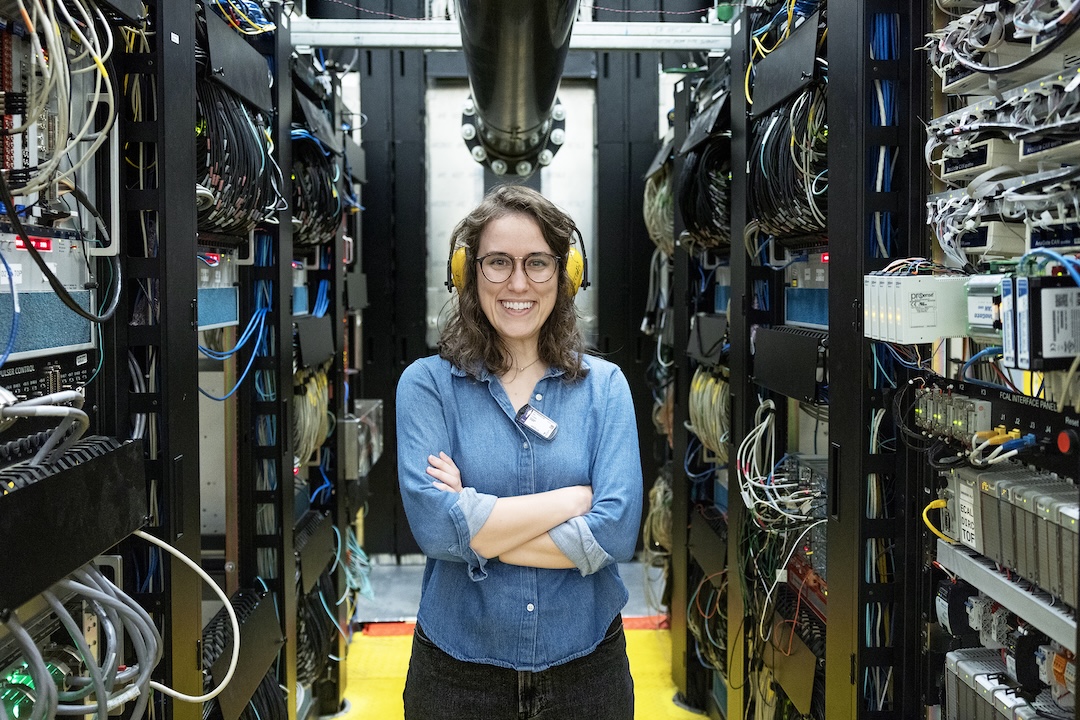
(Credit: Jefferson Lab)
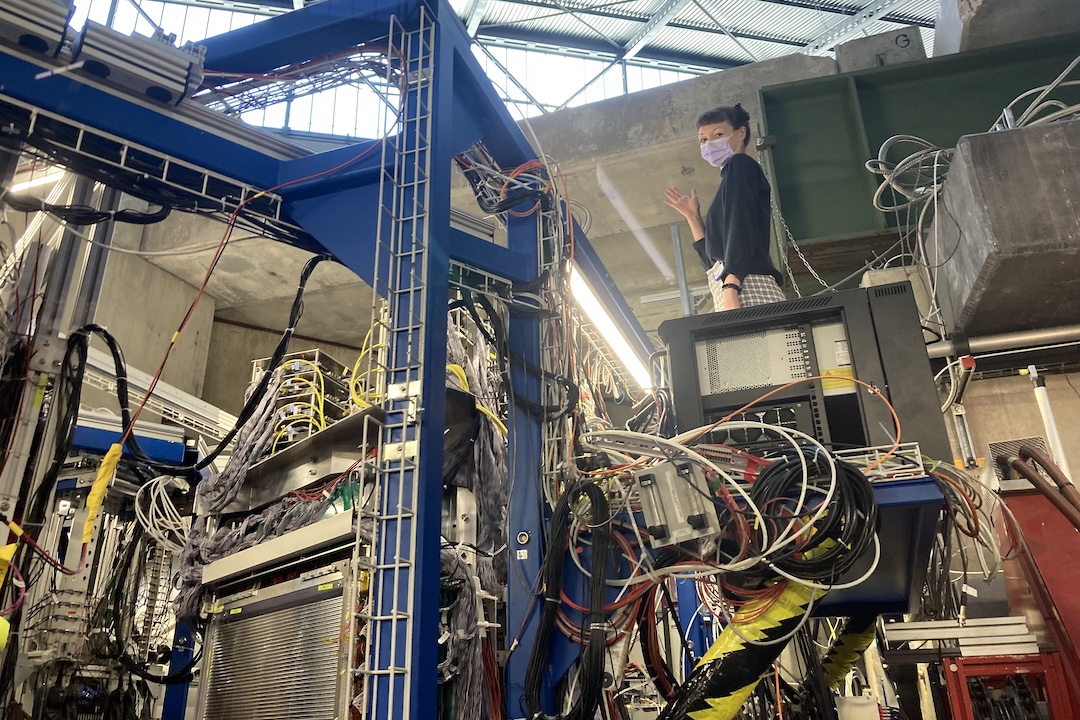
(Credit: Evangeline Downie)
9-to-5 Need Not Apply
At research hubs like JLab and PSI, “our students do basically everything,” Downie said. Indeed while patching detector leaks and draining dehumidifiers may not sound like real science, she emphasized that students are learning the day-to-day realities of a working physicist—while also filling their resumes with journal bylines and sought-after skill sets in project supervision and team management. “It’s very, very far from a 9-to-5 job,” Feldman said.
For a GlueX detector upgrade that Schmidt predicts will jolt his gluon experiments into a new phase, then-undergraduate Quinn Stefan, B.S. ’25, spent summer 2023 preparing 1,600 energy-absorbing crystal bricks that help the machine catch high-speed particles. During a two-month stint at JLab last summer, astrophysics senior Nippe-Jeakins helped complete the upgrade by stringing cables from the bricks to computer banks, sometimes pushing them with a broom handle under multiton detectors. “I’m not huge into instrumentation,” she laughed. “I kept thinking, ‘Please don’t let me break anything.’”
“I do love how one day you can be running simulations on particles that you can’t even touch—and the next you’re doing something super physical,” Stefan said. “There’s a connection between the physical instruments and the physics.”
And the scientists-in-training are also preparing for another reality about the world of experimental physics: They may not see the results of their research for years or even decades to come. The MUSE collaboration will collect data for five months in 2025, after taking 10 months of production data over the previous two years, and will take at least two more years to analyze it. And Schmidt said the full impact of his JLab work may not be felt for 50 years—if not longer.
“We’re still learning the rules of the game. The technology that comes out of this might be a long way away,” Schmidt said. Far from frustrated, however, Schmidt said he’s still inspired each time the accelerator fires. “These puzzles are confusing and mysterious and thrilling. We’re opening up new frontiers.”
Photography by William Atkins unless otherwise indicated.

